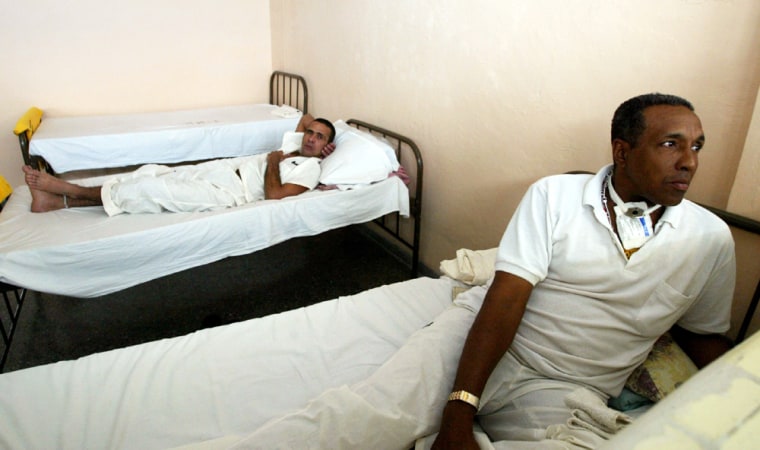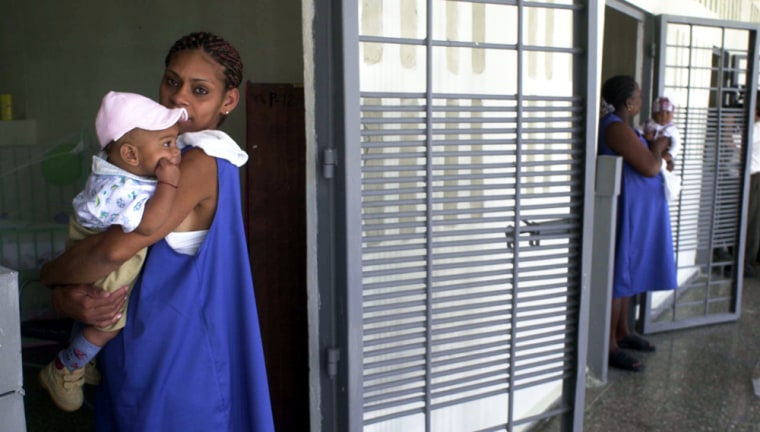Under an international onslaught of criticism, Cuba cracked open the door this week to its jails for the first time in almost 15 years.
Military officials gave several dozen journalists a heavily guided tour of prison hospitals at Havana's main penitentiaries: the Combinado del Este Men's Prison and the Manto Negro Western Women's Prison.
The unprecedented visit came as the United Nations Human Rights Commission prepares to vote on a resolution censuring the Cuban government for jailing 75 dissidents last year, convicted of being "U.S. mercenaries" plotting to subvert the socialist regime.
Both the dissidents and the Bush administration refuted the accusation.
Last week Cuba's Foreign Minister Felipe Perez Roque rejected international charges that the dissidents are subject to sub-standard prison conditions and medical care.
View of Cuban jails: computers, top medical facilities
For five hours on Wednesday, Ministry of the Interior officials shepherded reporters through model health care facilities equipped to provide everything from basic medical checkups and dental work to major surgery.
The tour did not permit a look inside any other building in the sprawling penitentiaries. Off limits — the four-story cement housing blocks, libraries, and Cuba's famed conjugal visit rooms.
The glimpse did provide the opportunity to speak with several handpicked inmates — either hospitalized or in job training programs.

Juan Carlos, 35, sentenced to 9 years for battery, spends his days in prison sitting in a freshly painted classroom, studying on an IBM computer, or learning to draw blood.
"I wanted to study a profession and do something useful while I serve my time and after I'm out."
He's one of 16 inmates in a nurses-training pilot program started by hospital director Dr. Aurelio Gonzalez in February. "We want to boost their self-esteem. Lots think that just because they committed errors, they can't be educated."
Dr. Gonzalez admitted that his prison-trained nurses will face a reluctant public once they are released and look for work in the general population. "All ex-convicts carry a stigma. That's why the Public Health Ministry will help place them."
Upon finishing the one-year course, the inmates will posses nursing diplomas that won't disclose where they studied. During their incarceration, they can either continue staffing the Havana penitentiary hospital or transfer to another prison.
As the press traipsed through post-op wards, operating rooms and laboratories, few inmates could be spotted outside the sterile hospital.
About 50 men, predominantly young and black, were exercising under the watch of armed guards, patrolling inmates running around a track or playing a hard game of volleyball. Other inmates were locked in housing blocks, peering through the vertical-slatted windows of "Unit 2".
Prison courtship
Reporters, accompanied by military doctors and prison officials, heard a number of prisoners including Sara Hernandez Valdez, 41, describe overall conditions as "acceptable."
Set for release next month on conditional parole after serving half of a 12-year sentence for counterfeiting public documents, she lives in the prison maternity ward with her seven-month-old son, Pablo Rafael. His father is an inmate at Combinado del Este, serving a 30-year sentence.
Two years ago, the two met and began courting in a prisoner letter exchange. Soon after, they married and wanted to start a family.
"It wasn't an easy decision to have a baby in jail. The conditions are pretty bare. But I saw other women do it."
During her pregnancy, she was moved to the maternity block and now lives in a strip of open cells with other mothers and babies. Her windowless room is sparse but clean, with two narrow beds covered in stiff white sheets, two ornate cribs and a cramped closet filled with baby items. White walls are decorated with colorful murals of Mickey Mouse and the metal bar door never closes.
Under Cuban penal code, female prisoners have the right to live with their babies until the child's first birthday. After that, the child is sent to live on the outside with family and allowed weekly visits. The average inmate is entitled to just one monthly three-hour family visit.
Last year prison doctors here attended to 48 pregnancies and 37 births. According to Dr. Orestes Gonzalez, both infant and maternal mortality are at zero with pregnant women receiving up to 2,800 calories a day. He claims the prison's regular population consumes 2,480 calories, in line with international standards.
During Wednesday's tour, prison officials refused to divulge any statistics on Cuba's prison population, insisting that numbers were not available.
However, an inmate at Combinado del Este claimed the men's facility housed 3,000 convicts while Mirelyis Ramirez, serving a nine-year sentence for armed robbery, said Manto Negro held 800 women.
Elizardo Sanchez, a dissident who heads up an illegal but tolerated prisoner's watch group — the Cuban Commission on Human Rights and National Reconciliation — estimates the prison population at 80,000, including more than 300 political prisoners of conscience
scattered across the island.
Families of 75 dissidents continue demands for release
On the one-year anniversary of the roundup of the 75 dissidents, their wives and relatives are appealing for their immediate release, describing prison conditions as deplorable and the convicted as innocent.
Amnesty International has echoed those demands:"After a detailed review of the legal cases against them, it is clear that they are prisoners of conscience, detained for the peaceful
expression of their beliefs."
The Cuban government takes issue on both counts, claiming that authorities treat the "75 mercenary prisoners" with respect and that it "has the right to take measures to protect the country".
At the time of the arrests, Havana found particularly irksome not just the enormous amount of U.S. government funds being pumped into programs seeking regime change -—$32.3 million last year — but also the increasing number of meetings between dissidents and America's top diplomat, James Cason.
Foreign Minister Perez Roque last week vowed his government would punish "anyone who collaborates with a foreign power" to overthrow the system.
Blaming the crackdown on Cason's "provocative actions," Roque continues to hold "the U.S. government responsible for any measures Cuba takes to defend the country."
Senior State Department officials posted here in Havana held a background briefing this week during which Roque's charges were described as "absurd."
Speaking on condition of anonymity, one official challenged the Castro government to stop shifting blame for its own failed economy and policies.
"The regime has been in total power for 45 years and never owns up to its mistakes... If we could manipulate the Cuban government, we'd do it."
